BY LETTER
Bonfire System, The
Galactography > Regions of Space > Middle Regions/Hinter-regions
Galactography > Sephirotic Empires > Mutual Progress Association
Galactography > Systems and Worlds > Systems & Worlds A - B
Galactography > Sephirotic Empires > Mutual Progress Association
Galactography > Systems and Worlds > Systems & Worlds A - B
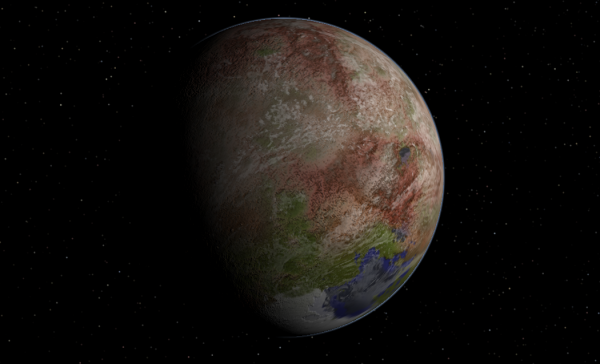 Image from Steve Bowers | |
| Ember, a dry terrestrial world in this system | |
Bonfire - Data Panel | |
| SYSTEM OVERVIEW | Government: Transapient-arbitrated cyberdemocracy. Population: 2 billion modosophonts (82% vec, 15% neb), est. 50,000 S1 transapients |
|---|---|
| STELLOGRAPHY | Primary: Bonfire Stellar Type: M4V Distance from Sol 1381 ly Constellation: Scutum Right ascension: 18h50m58.50s Declination: -09°46'27.0 |
Bonfire is 3.6x Sol's apparent diameter from the surface of the world Ember, and appears (to human eyes) as a large, white disk the same color as an incandescent bulb's filament. It is a fairly old and calm red dwarf, rarely given to sprawling star spots or flares. The star is only lightly developed. A collection of "Brooklyn Beam Emitters" are scattered across its surface to provide beamriding links on demand, and there is a star-skimming (0.005AU) solar collection belt that beams power to various industrial facilities throughout the system. Bonfire does have a small number of Vulcan asteroids inside the orbit of the first planet, Coal. They are currently lightly developed except as a vacation spot and hosts to a couple of S2 A-brains thriving in the high energy environment.
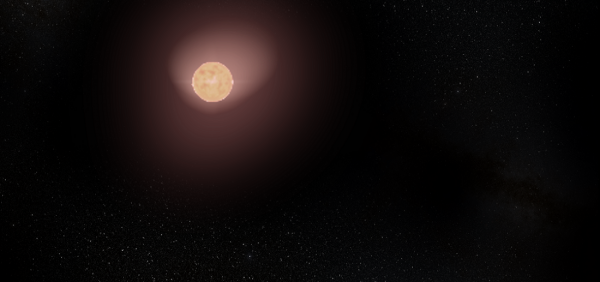 Image from Steve Bowers | |
| Bonfire, a small main sequence red dwarf | |
Coal
| Planet 1 | Coal Semi-Major Axis: 0.049AU, 8.6-day orbit Mass: 0.7x Earth Density: 6.2g/cc Radius: 0.78x Earth |
|---|
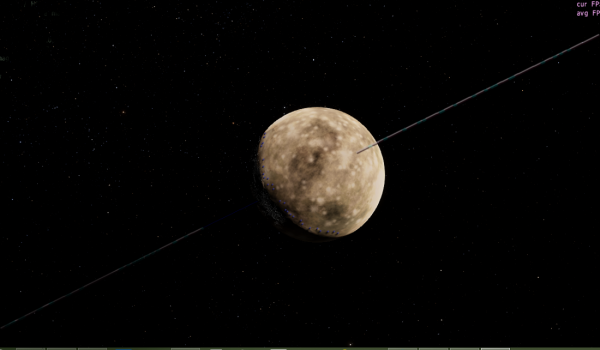 Image from Steve Bowers | |
| Coal, a tidally-locked ferrinian world with Lagrange space elevators | |
Ember
| Planet 2 | Ember Semi-Major Axis: 0.07AU, 14.8-day orbit Type: HyperXeric Gaian. Mass: 0.75 Earth Density: 5.5g/cc Radius: 0.9 Earth Gravity: 0.9 gees Day Length: 98.4 hours |
|---|
Bonfire and Ember are both fairly old, 6 billion years. This has aided Ember's habitability because Bonfire is well past its flaring and severe sunspot age and is now a quite-docile main sequence red dwarf. On the other hand, Ember is less massive than Earth, so its long life has allowed its core to cool considerably and leave it with a planetary magnetic field only 3% as strong as Earth's. This led to a steady erosion of its atmosphere. This depletion was useful: Ember was a lifeless eo-To'ul'hese-type world billions of years ago. By the time Terragen explorers arrived, Ember's atmosphere had cooled and thinned appreciably, making it an easy terraforming target. The near-cessation of plate tectonics has not been a problem because Ember receives 12% more illumination than Earth (including infrared), so the ongoing depletion of atmospheric carbon dioxide is useful in keeping temperatures low. The negligible tilt has produced large ice caps and dry northern and southern supercontinents that also moderate temperatures. While subduction and other tectonic activities are limited, Ember does have a couple of large super-volcanoes over mantle hot spots. The planet receives a little tidal flexing from its two neighbors and Bonfire, which accumulates in those hot spots.
Like Smoke, Ember is dry world of salt flats, sand ergs, and rocky deserts. The world's long-gone wet era created powerful erosive forces and vast sand stone beds. In the last couple of billion years, though, its thinning, desiccated atmosphere eroded those into the vast ergs that attracted the current residents. The dune seas are punctuated by plateaus, buttes, and mountains of hard rock that have survived billions of years of erosion.
Ember has very little surface water other than its icecaps and meltwater runoff from them, which form some short rivers and small lakes in arctic regions. The rest has accumulated close to its major mountains that have some orographic precipitation. The alpine meadows and scrub forests on those mountains are treasured retreats for occupants. In addition, the terraforming process deliberately created large aquifers in strategic areas of the planet.
A variety of hardy, salt- and UV-tolerant plants, lichens, and microbes sustain the world's oxygen levels against geological sequestration, and tend to be the tips of food chains that stretch down to the aquifers. This desert ecosystem is not innovative, having borrowed stock lifeforms engineered for other HyperXeric worlds around terragen space. The shortage of atmospheric CO2 has led plants to be engineered with nearly closed-cycle respiration, preserving CO2 for its improved CAM-style photosynthesis. They also have symbiotic root bacteria that produce CO2 from carbon in the soil, such as carbonates.
The long days and relatively flat terrain produce predictable eastward winds across most of the planet. Wind patterns become more complicated past the arctic and antarctic circles because of the cold poles and their moisture. Dust and sand storms are very common near the equator simply due to the large amount of sand, dry salt, fine silt, and steady winds, but katabatic winds of cold air falling off the icecaps also stir turbulent storms. Dust devils are also common near the poles when the descending cold air traps warm surface area below it. Daytime peak temperatures (some hours past noon) are uncomfortably high for terrestrial life, often exceeding 70C near the equator, while the long nights and lack of thermal mass cause temperatures to plummet below freezing. Sheltering below ground is a common survival strategy for plants and animals alike.
The planet is settled by a number of neb, tweak, and rianth groups that embrace its harsh conditions. There are small villages and towns, usually inside or atop mountains and buttes, but the majority of the population is nomadic and sometimes hermits. Few are prims. This is a very high tech desert world where nomad groups are well-equipped with portable forges, thicksuits, and various vehicles that suit their preferences.
The prevailing winds and powerful thermals are friendly to solar-augmented gliders and wingpacks. Meanwhile, the ergs favor legged animals and vehicles - some as large as houses on long, dune-conquering legs. Sail-powered land yachts thrive in the flat lands. Some residents have indulged in whimsies, leading to the ongoing "Skypirate" culture-hobby. An elevated maglev train network provides more practical transport. This has major tracks circling the equator, perimeter of the icecaps, and 90-degree meridians, plus branches to permanent communities.
The capital city of Roraima is located on the equator in and on a tepuy, which juts like a rusty brown iceberg from the surrounding white salt flats. The planet's primary spaceport occupies part of the flat top of this mountain, while artificial caves and terraces dot its flanks. The interior has been honeycombed with diamondoid-reinforced tunnels and chambers that the 25,000 residents make into homes, businesses, and public spaces. In its lower levels the city has some water-filled reservoirs that act as thermal masses to battle daytime heat and provide some of the rare swimming areas on the planet. Roraima's tepuy is at the southern end of a chain of spectacularly wind-sculpted tepuys, buttes, and mesas that run to the northeast and host about 10,000 more residents in smaller communities. The surrounding salt flats are popular with land yacht users, who brightly decorate their vehicles. Traffic ranging from one-person racers to big cargo barges weave around the rocks like colorful butterflies.
Access to Ember is eased by a Lagrange skyhook, Sirocco, which has a docking facility and ballast asteroid in a halo orbit around the Bonfire-Ember L1 point. The low end of Sirocco is platform about 150 kilometers above Ember, and has both landing platforms and residential areas. Ember's slow spin moves the surface at about 350 kilometers per hour relative to the skyhook, so reaching it is a modest exercise for even chemical rocketry. Descent is simply a case of dropping free from a platform. An unpowered vehicle will reach a peak speed of about 1400m/s before encountering significant aerodynamic drag. While many spaceports host magnetic catapults to boost spacecraft toward Sirocco, a common means of accessing it are Sirocco's smart grapples: these powered cables drop into the atmosphere to pick up compatible flying vehicles on request, and are able to pick up cargo and vehicles off the back of eastbound equatorial maglev trains.
Ember has a biogeocomputing substrate in its bedrocks. This serve as some slow public computronium, but primarily hosts an S2 entity ("Rocky" to eir friends) who oversees Ember's defense, inter-polity relations, and environmental management as an administrator for the system government.
Smoke
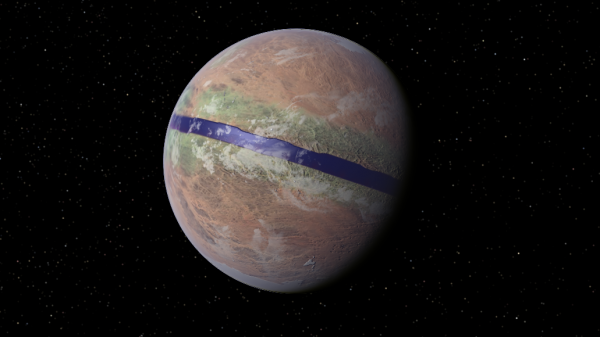 Image from Steve Bowers | |
| Smoke has a World River around its equator, on average around 400km wide | |
| Planet 3 | Smoke Semi-Major Axis: 0.105AU, 27-day orbit Mass: 0.7x Earth Density: 4.5g/cc Radius: 1.08x Earth Day Length: 24 hours More details below |
|---|
Like Ember, Smoke is an old world that has seen its continental drift halt, its magnetic field falter, and old oceans and atmosphere disappear into space. Terraforming addressed most of this conventionally with imported nitrogen and water, and oxygen cracked from planetary rocks. The acceleration of its spin from 27 days to 24 hours is causing the planet to become gradually more oblate, which is leading to significant seismic activity and creation of rift valleys where the thick crust fractures.
The rift valleys are still nascent, allowing the world's geography to be instead dominated by the artificial World River. This ocean covers 4% of Smoke's surface and runs almost perfectly around the equator. Much like the artificial continents of New Earth, it was excavated by vast von Neumann swarms who sculpted the equator into a deep, regular canal 500 kilometers wide. The World River is not just regularly shaped, it is lined with cut stone and has numerous current-modifying features on its floor and walls to damp tidal flow because Bonfire's tidal effects are 92 times greater than Luna on Earth. Even so, bays and branch canals typically see tidal variations at the extremes of those experienced by Earth, and large whirlpools often develop along the edge of flow-damping weirs. Maintenance of the World River's lining and preventing flow modification from silting is an ongoing project of "mucker bots," bots controlled by the planetary mind ranging in size from synsects to larger than whales.
Tides and earthquakes aside, the World River was built as a durable, scenic element of the planet. The cliff walls that tower as much as three kilometers above the river (where it cut old mountain ranges) are made of giant, interlocking blocks of artificial sapphiroid and quartz produced during the excavation, typically slightly sloped for stability. Above water, the walls are molded with enormous bas reliefs, statues, and gardened terraces for the inhabitants. The water retains heat better than the surrounding land, so fogs rise with clockwork regularity at dawn and rains fall in the afternoon as the humidified air begins to cool. Carved branch canals from the north and south walls of the World River recover precipitation from surrounding lands and support transport to the agricultural areas along them. Because of the depth of the World River, the land beyond its cliffs is effectively a plateau and the branch canals require numerous locks and dams to reach the river, all of which are exercises in advanced engineering: crystalline diamond dams, rotary boat lifts, flo-stone morphing locks, and so on. There are gardened islands in the World River, too, reinforced like the cliff walls to resist tidal erosion and provide scenic real estate in the center of the river.
The population is concentrated in New Venice, an arcology of 4 million people built into a tall stretch of cliffs and nearby islands on the World River. While New Venice does have canals at its base, it is more distinctive for complicated, gardened terraces and buildings carved in its soaring cliffs, not to mention several dramatic flights of locks that descend through the city from surrounding plateau country. The other million residents of the planet live scattered in individual homes and small villages along the World River or in the agricultural areas around it.
Beyond the forest- and prairie-covered tropics, which are actually subtropical in temperature, Smoke desiccates to a world of cool salt flats, cold rocky deserts, weathering mountains, and finally the large ice caps. Some briny, frigid seas survive around the perimeter of the ice caps. There are several volcanic regions akin to the Tharsis Bulge of Mars where hot spots have developed under the motionless crust. The two volcanic regions within 25 degrees of the equator have developed belts of forest and plains due to orographic rain caught on their flanks, but develop glaciers and finally arid deserts toward their peaks. The third hot spot is centered at 62 degrees north and thus cold from its foothills to its peaks, with little moisture but glaciers.
Smoke has a BGC "world mind," and S2 entity that answers to "Tharsis." Tharsis seems preoccupied with regulating the World River and rarely deals with residents directly, instead preferring to use a clade Darwin entity resident in New Venice as a representative.
Cinder
| Planet 4 | Cinder Semi-Major Axis: 0.175AU, 58-day orbit Type: LithicGelidian. Mass: 0.01x Earth Density: 3.1g/cc |
|---|
The modosophont vecs have a rich and varied industry, culture, and economy that is similar to vec-dominated worlds across Terragen space, from the MPA to Metasoft. Previously, Cinder was girded by dense mass driver streams of water, ammonia, and other volatiles being flung to Smoke for that world's terraforming, streams that were fed by Von Neumann bot swarms mining, processing, and loading continents' worth of materials. Most of the subsapient bot swarms are now quiescent or even recycled, but their vec tenders remain active in ultratech urban districts.
A small percentage of the population remains engaged in mining operations, which support the modest light element needs of the star system's ultratech industry, but most are involved in the world's leisure economy. A similar percentage of hobbyist vecs have taken up the habit of ice sculpting, but on a giant scale. The under-employed vecs entertain themselves with gigantic ice carving contests, apparently awarding themselves points for how much shock and dismay they can create in local modosophont media with their "art." That the vecs were using their spare time to etch the planet's surface was first noted in 9451AT when a passing ship spotted a 100-kilometer long line-carving of a rude symbol on Cinder's equator. Since then, the vecs will spend years or decades carving icy wonders (e.g., the 9890AT 1:1 recreation of Paris, France as it appeared in 1 AT), thus "rehabilitating" their work with local modosophonts, and then deliberately produce something outrageously crude. For example, the rude symbol gained an appropriately aligned counterpart in 9762AT. The 10405AT "Wuppist Forest" is the record-holding piece of 'outrage carving.' It consists of flawlessly-carved statues of local politicians and celebrities 100 to 1000 meters tall in the middle of an elaborate Wuppist ceremony. The Wuppist Forest garnered a record number of 'points' because it outraged locals to the point they hired warlawyers. While "Wuppist Forest" looks like a normal, multi-party Wuppist act to most modosophonts, it apparently offensively lampoons several tenets of local ideologies.
Ash
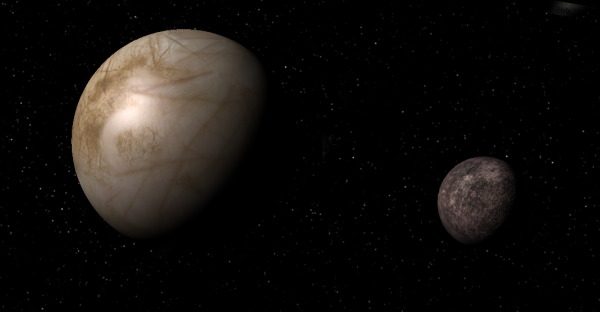 Image from Steve Bowers | |
| Ash and Vibhuti | |
| Planet 5 | Ash Semi-Major Axis: 0.35AU, 165-day orbit Mass: 0.3x Earth Density: 3.2g/cc Moons: 1, Vibhuti |
|---|
The moon Vibhuti hosts a small shipyard that does not accept modosophont traffic; only ships carrying transapient visitors are permitted to approach. Here the ships appear to undergo repairs and other servicing. Debris shields are rebuilt and, for ships with reaction engines, reaction mass and fuel supplied.
Pogonip
 Image from Rhea 47 | |
| Pogonip | |
| Planet 6 | Pogonip Semi-Major Axis: 5AU Type: Cryojovian. Mass: 15x Earth Density: 1.3g/cc Moons: 11 |
|---|
Today, Pogonip is little used. It has a few bubble habitats established by private individuals. Some of Cinder's ice mining vecs retired to Pogonip's moons, and have since spawned the vec haloist population of Buran.
Buran
| Kuiper Belt | Buran Distance from Bonfire: 11 to 35AU |
|---|
Related Articles
Appears in Topics
Development Notes
Text by Mike Miller
Initially published on 25 January 2018.
Initially published on 25 January 2018.






